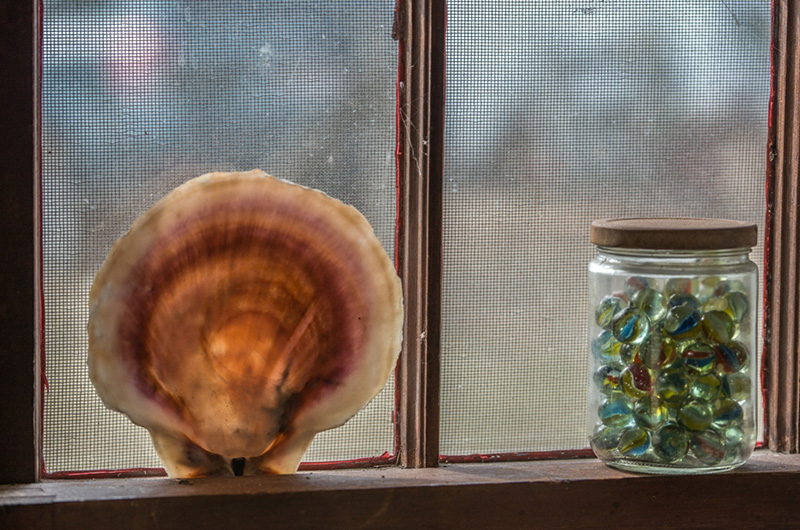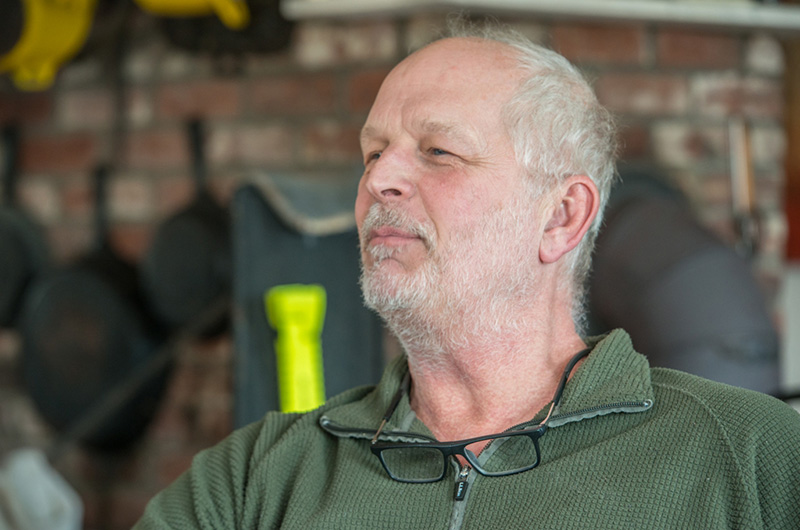There are about 700 permits of various classifications issued by the federal government to fish for sea scallops on the East Coast.

Sam Hopkins of West Tisbury has one of them. In the heydey of the sea scallop fishery, there were as many as seven boats from Martha’s Vineyard plying the waters for sea scallops. Now Mr. Hopkins is the only Islander still fishing for the deep sea delicacy.
His boat, the aptly named Endurance, is a 49-foot fiberglass and steel vessel that carries a crew of two in addition to Mr. Hopkins. He aims to make a trip a day when the fishing is good, motoring as much as 10 hours, with him and the crew taking watches and getting some sleep and a meal before arriving at the fishing grounds to drop their dredge. With luck the scallops will be plentiful, and they will have their quota quickly.
“We try to do a trip in under 24 hours,” Mr. Hopkins said in a recent interview at his small farm near the top of Christiantown. “We’ll do whatever it takes to get it, sometimes it’s two tows, sometimes it’s three or four. In the open bottom when fishing is scratchy, sometimes it's 30 hours to catch them. We come in, unload, turn right around and leave.”
In a recent season when the fishing was good and the price was high, Mr. Hopkins and crew made a trip a day for 53 consecutive days.
It is a nomadic existence during the fishing season. The price of fuel often dictates landing his catch at the closest port to the best scallop fishing. That might be Hyannis, New Bedford, or even Cape May, New Jersey. In recent seasons, it also included Menemsha. Last week Endurance was tied up for a day at Memorial Wharf in Edgartown.
Mr. Hopkins had been a sea scallop fisherman for a long time when the newly formed Martha’s Vineyard Fishermen’s Preservation Trust approached him with a proposal. The trust wanted to replicate a model that has been successful on Cape Cod and on the West Coast, where nonprofit organizations hold a permit for scallop fishing, and lease the quota out to local fishermen.

Like his colleagues in the scallop fleet, Mr. Hopkins faces a bewildering maze of regulation, permitting, quotas, and economic forces as he tries to make a living from the ocean. Add to all that the unpredictability of wholesale scallop prices, which are set at auctions, and it makes for an uncertain profession.
At this time of year, fishermen are competing for quota on the open market. Mr. Hopkins owns some of his own quota, buys a small amount from the fishermen’s trust, and buys the rest on the open market.
Because he gets some of his quota on the Vineyard, he lands some of his catch here, keeping the Island fishery alive.
He said the lease arrangement with the fishermen’s preservation trust has helped. “They provide some elasticity to the small boat fishermen that isn’t there if we just have to compete against the big industry players,” he said. “It works two ways. It preserves the small boat fishing community. But it also allows them to steward the resource a little bit. They can have an effect on fishing regulations, and on how and when stuff gets caught. It provides kind of a safety net. If I had to compete right off the bat at market prices before the season started it would put me at a disadvantage.”
Last year Mr. Hopkins landed 20 trips in Menemsha. He sells what he can to local fish markets, who value freshness and quality of the deep sea scallops.
“Local markets do support what we’re doing, they support catching local stuff, so they’ll buy the stuff off the boat at a little premium,” Mr. Hopkins said.
Whatever the fish markets can’t handle, he sells to wholesalers on the Island, and if the wholesalers can’t handle the catch, he sells the rest to wholesalers elsewhere.
Fishing for sea scallops is not for the faint of heart. The overhead can be astronomical, when accounting for crew, ice, fuel, grub and the cost of purchasing fishing quota. It all starts with a boat that has to run nearly nonstop during the fishing season.
“It’s a complicated machine,” Mr. Hopkins said. “It’s a 400-horse Caterpillar diesel. It’s another 1,700 kilowatt generator, a bunch of pumps, a bunch of electronics. He estimates the cost of operating and maintaining the boat eats up half of the revenue he gets from selling his catch, which is limited to 600 pounds of cut scallops per trip.
“You’re not too far above break even when you hit your 600 pounds,” Mr. Hopkins said. “You don’t make any money coming in with 450 pounds. You break even around 500 pounds. That last 100 pounds you catch is the profit. That’s what the guys put in their pocket to take home. We have been asking to go up on the quota to allow us to catch more per trip.”
The hard work, bureaucracy and precarious nature of the business have left many in the seas scallop industry behind. But Mr. Hopkins navigates the obstacles both on and off the water to keep a little bit of the long tradition alive here on Martha’s Vineyard.
“What else are you going do,” he said. “I’ve worked for a bunch of good people, When I was younger I worked with a bunch of good people here on the Vineyard, that taught me enough that I could go out and do this in other places. You kind of write your own schedule. There are not a lot of places where you can do that. You don’t have to punch a clock, and you’re working for yourself. I can’t complain about anything. It’s on me.”







Comments (8)
Comments
Comment policy »